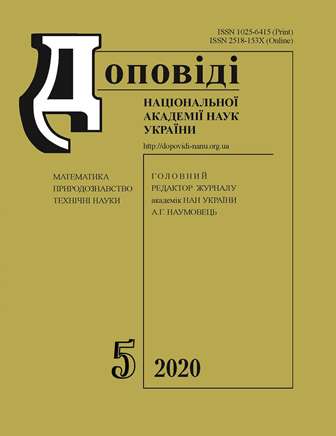Особливості зміни структури й електрофізичних характеристик n-Si під впливом різних режимів термообробки
DOI:
https://doi.org/10.15407/dopovidi2020.05.042Ключові слова:
кремній, мікроструктура, теплові нейтрони, термічний відпал, холлівські параметри, швидкість охолодження, ядерна трансмутаціяАнотація
Досліджено кристали n-кремнію, леговані домішкою фосфору як традиційним металургійним способом (у процесі вирощування через розплав), так і методом ядерної трансмутації (перетворення ізотопів кремнію у процесі захоплення ними теплових нейтронів). Принципова відмінність трансмутаційного легування від металургійного способу легування полягає в тому, що легувальні домішки не вводяться у вихідний матеріал ззовні, а утворюються в процесі опромінення безпосередньо з атомів матеріалу, який легують. З метою відпалу радіаційних дефектів та активації атомів фосфору-31, які в об'ємі кремнію виявляють донорні властивості тільки у вузлах ґратки, трансмутаційно легований кремній попередньо піддавали технологічному відпалу за температури 850 °С протягом 2 год, а вже потім — термічним обробкам з подальшим охолодженням із різними швидкостями. Виявлено вплив як тривалості термічного відпалу, так і швидкості охолодження від температури відпалу до кімнатної на зміну структури й електрофізичних характеристик кристалів n-Si 〈P 〉, легованих через розплав і методом ядерної трансмутації. Виявлено появу дислокацій у трансмутаційно легованих кристалах Si після високотемпературного відпалу протягом 2 год і подальшого швидкого охолодження. Встановлено, що високотемпературний відпал протягом 72 год зразків Si, незалежно від способу легування домішкою фосфору, сприяє генерації глибоких донорних центрів, як при повільному, так і при швидкому охолодженні, й істотно знижує концентрацію носіїв заряду.
Завантаження
Посилання
Bukowski, A. (2013). Czochralski-grown silicon crystals for microelectronics. Acta Physica Polonica A, 124, No. 2, pp. 235-238. Doi: https://doi.org/10.12693/APhysPolA.124.235
Chervonyi, I. F., Kutsova, V. Z., Pozhuiev, V. I., Shvets, E. Ia., Nosko, O. A., Yehorov, S. H. & Voliar, R. M. (2009). Semiconductor silicon: Theory and technology of production. Zaporozhye: Zaporizka derzhavna inzhenerna akademiia (in Ukrainian).
El-Kareh, B. (2009). Silicon devices and process integration. Deep submicron and nano-scale technologies. New York: Springer Science+Business Media, LLC.
Baranskii, P. I., Belyaev, O. E., Gaidar, G. P., Kladko, V. P. & Kuchuk, A. V. (2014). Problems of the diagnostics of real semiconductor crystals. Kyiv: Naukova Dumka (in Ukrainian).
Murin, L. I., Lindstrom, J. L., Davies, G. & Markevich, V. P. (2006). Evolution of radiation-induced carbon—oxygen-related defects in silicon upon annealing: LVM studies. Nucl. Instrum. Meth. Phys. Res. B, 253, No. 1-2, pp. 210-213. Doi: https://doi.org/10.1016/j.nimb.2006.10.029
Mezhennyiy, M. V., Milvidskiy, M. G. & Reznik, V. Ya. (2009). The effect of fast thermal annealing on the features of defect formation in silicon wafers while creating an efficient internal getter. Poverhnost. Rentgenovskie, sinhrotronnyie i neytronnyie issledovaniya, No. 8, pp. 49-56 (in Russian).
Shlimak, I. S. (1999). Neutron transmutation doping of semiconductors: science and applications. Fizika tverdogo tela, 41, No. 5, pp. 794-798 (in Russian). Doi: https://doi.org/10.1134/1.1130856
Babich, V. M., Bletskan, N. I. & Venger, E. F. (1997). Oxygen in Silicon Single Crystals. Kyiv: Interpres LTD (in Russian).
Pesola, M., Lee, Y. J., von Boehm, J., Kaukonen, M. & Nieminen, R. M. (2000). Structures of thermal double donors in silicon. Phys. Rev. Lett., 84, No. 23, pp. 5343-5346. Doi: https://doi.org/10.1103/PhysRevLett.84.5343
Emtsev, V. V., Jr., Ammerlaan, C. A. J., Emtsev, V. V., Oganesyan, G. A., Misiuk, A., Surma, B., Bukowski, A., Londos, C. A. & Potsidi, M. S. (2003). Oxygen agglomeration and formation of oxygen-related thermal donors in heat-treated silicon. Cryst. Res. Technol., 38, No. 3-5, pp. 394-398. Doi: https://doi.org/10.1002/crat.200310049
Usenko, A. E. & Yuhnevich, A. V. (2009). Detection of microdefects in perfect single crystals of silicon by the method of selective dissolution. Izvestiya Vyisshih uchebnyih zavedeniy. Materialyi elektronnoy tehniki, No. 2, pp. 38-43 (in Russian).
Nijdam, A. J., Gardeniers, J. G. E., Gui, C. & Elwenspoek, M. (2000). Etching pits and dislocations in Si {111}. Sensors and Actuators A, 86, No. 3, pp. 238-247. Doi: https://doi.org/10.1016/S0924-4247(00)00458-1
Usenko, A. E. & Yuhnevich, A. V. (2007). Features of the surface morphology of silicon single crystals when dissolved in acid polishing etchants. Zhurnal obschey himii, 77, No. 3, pp. 400-404 (in Russian). Doi: https://doi.org/10.1134/S1070363207030085
Khorosheva, M. A., Kveder, V. V. & Seibt, M. (2015). On the nature of defects produced by motion of dislocations in silicon. Phys. Status Solidi A, 212, No. 8, pp. 1695-1703. Doi: https://doi.org/10.1002/pssa.201532153
##submission.downloads##
Опубліковано
Як цитувати
Номер
Розділ
Ліцензія
Авторське право (c) 2023 Доповіді Національної академії наук України

Ця робота ліцензується відповідно до Creative Commons Attribution-NonCommercial 4.0 International License.




